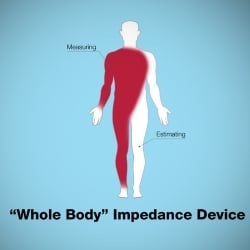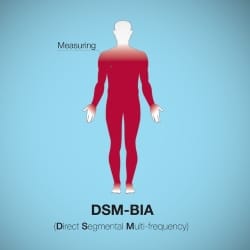DSM-BIA: the future of body composition analysis
Although well-known, and commonly used in home and consumer fitness equipment, BIA technology has been disregarded for many years when it comes to precision for medical or professional purposes. However, those concerns are legitimate as early BIA devices had serious design flaws.
Direct Segmental Multi-frequency Bioelectrical Impedance Analysis (DSM-BIA) technology represents the future of body composition analysis and BIA technology. Older BIA devices have major design flaws that limited their reliability and the reproducibility of their results; however breakthrough technology by InBody (GE Healthcare) has created research grade DSM-BIA technology that has overcome those issues with advanced technology.
How reliable is DSM-BIA? Extremely! In fact, our DSM-BIA devices now produce results that mirror results generated by DEXA, an industry-regarded gold standard. By improving BIA technology, DSM-BIA devices blend the precision expected from gold standard equipment, all with the convenience and ease-of-use provided by traditional BIA devices.
Why Does BIA Get a Bad Name?
The majority of concerns regarding BIA technology comes from from three outdated types of BIA-technology applications. If you’re concerned about the accuracy of the older BIA devices, there are some very legitimate reasons.
These devices fall into three general groups:
- BIA Scales
- Handheld BIA Devices
- “Whole Body” Impedance Devices
However, a new fourth type of BIA is now avaiable, Direct Segmental Multi-frequency Bioelectrical Impedance Analysis (DSM-BIA). DSM-BIA devices provide true BIA precision that matches the gold standard equipment, however, it’s more convenient, and affordable compared to other types of equipment. DSM-BIA has been tested to be within 98.4% accurate to a DEXA / DXA test. The only reason DSM-BIA is not the gold standard is simply because it’s still so new. Some groups are starting to catch on, including big names like the Los Angeles Lakers, UCLA Medical Group, Navy Seals, and the CIA. DSM-BIA has been featured as the best method in clinically tested in peer reviewed journals.
Below, is a brief comparison of the types of technologies, and why DSM-BIA is quickly emerging as the best, most affordable test for the majority of the population (outside of extremely obese individuals and very young children).

BIA Foot Scales
BIA Foot Scales
This is a traditional digital scale that incorporates BIA technology to determine body fat percentage. Many people have purchased these to use at home, unfortunately they can be wildly inaccurate. The device requires your age, height, and gender and computes your data for your body fat percentage while standing on the scale.
However, the accuracy of such a device has some serious flaws. What’s important to know is BIA scales such as these only send a current up one leg and down the other. This means that impedance (the metric that all BIA devices use to compute results) is only directly measured in the legs. They use your leg data to estimate the whole body to estimate your body fat. You should not feel confident in BIA foot scales.

Handheld Devices
Handheld BIA Devicess
Handheld BIA devices such as the ones carried by many gyms can be even more unreliable.These devices operate similarly as BIA scales, except instead of measuring the legs, handheld BIA devices send the current from one arm to the other. They will then estimate everything from your chest down. This means that these devices are guessing what your overall body composition is based on the composition of your arms.
Inaccurate results are common for the majority of the population. For example, if your arms are the most muscular part of your body and you carry the majority of your fat in your midsection, a handheld BIA device will not be able to account for these differences. Handheld BIA devices only directly measure the arms. Everything else is just estimation and guesswork.

"Whole Body" Devices
“Whole Body” Impedance Devicess
There are also more conventional BIA devices that require you to lie down while a technician attaches adhesive electrodes to the whole right side of your body. Just like scales and handheld devices, these devices don’t measure the entire body, even though they might appear to do so. However, instead of completely missing the upper or lower half of the body like BIA scales and handhelds do, these devices operate differently – but have just as many issues.
In the case of conventional BIA devices, four electrodes are placed on the right half of the body. These devices is that they treat the entire body as a single unit or “cylinder.” This means that while the device is collecting data, it treats your arms in the same way it treats your trunk/torso. However, the trunk’s composition is significantly different than an arm (it contains the internal organs and contains a much greater amount of Lean Body Mass. These systems also provide false readings and inaccurate results.

DSM-BIA Analaysis
Direct Segmental Multi-frequency Bioelectrical Impedance Analysis (DSM-BIA)
The three devices described above are the only BIA devices most people are are familiar with. That’s why, including for those described above, people have very good reasons for having low confidence in older BIA technology. However, the industry has addressed the flaws by creating Direct Segmental Multi-Frequency Bioelectrical Impedance Analysis (DSM-BIA). It’s a the new, modern approach to BIA technology that, for the first time, directly measures the entire body.
Unlike any of the previous methods or devices above, devices that employ DSM-BIA do not leave any section of the body unaccounted for. DSM-BIA analysis has the body divided into 5 segments and the impedance for each segment is measured independently.
The best part of DSM-BIA technology is it allows a doctor, researcher, or fitness professional to create a full picture of a client’s body fat muscle and water composition. It allows each segment of the body to be measured independently, just as DEXA does, but does it much quicker and more conveniently than DEXA –one of the major advantages of using a BIA device.
An Easier, Better, More Accurate Way for Body Composition Analysis
DSM-BIA technology represents the future of body composition analysis and BIA technology. Older BIA devices have major design flaws that limited their reliability and the reproducibility of their results; DSM-BIA technology has responded to those flaws. By improving BIA technology, DSM-BIA devices blend the precision expected from gold standard devices with the convenience and ease-of-use provided by traditional BIA devices. It is possible to have the best of both worlds, after all.
When you test with us, within minutes, our body composition analyzer provides complete body composition easily, quickly, and hassle-free. There is no longer a need to use the less convenient and expensive DEXA scans, water tanks or sitting in an air displacement chamber. We will help you reach your health, wellness, and fitness goals with meaningful data points. We provide full-page, in-depth results sheet detailing the muscle, fat, and water values of your body in minutes to help you understand, track and improve you fitness.
